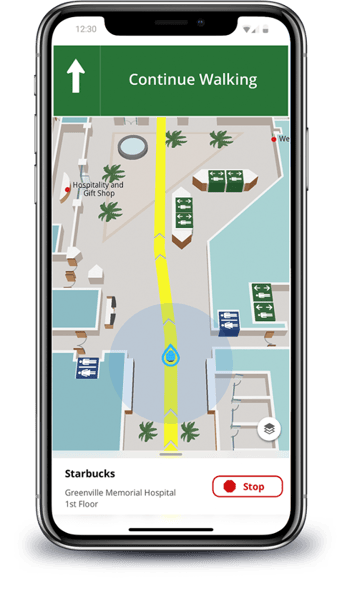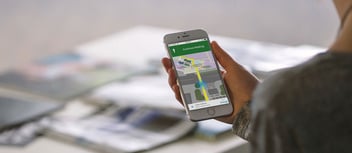For years, until the pandemic, hospitals asked staff to help patients who were lost. Since COVID, many patients now expect, and often want, a touchless experience. But patients are still getting lost in healthcare facilities. The best solution to this problem is to provide a digital wayfinding solution that can get patients from home to parking to the point of care.
Blue-dot navigation for hospitals is known to help with no-shows and late arrivals and relieve burden on staff, but there are other benefits that may come as more of a surprise.
New Staff Onboarding
It isn’t just patients who get lost in large, complex health facilities, it’s also staff. Twenty-five percent of hospital staff can’t find some locations in their health system. A robust wayfinding solution can also be used by staff to find their way. Most Gozio clients have new staff download their mobile app with wayfinding as part of their onboarding. Some even set tasks for new staff to find specific items and locations using the wayfinding in their mobile app to help them acclimate.
This is particularly helpful when hospitals expand either through mergers and acquisitions or new buildings. Existing staff may be moved to a new location. By adding new locations to the locations and wayfinding, they can navigate from home to the new location and find their way inside the building.
This is a great way to help relieve stress and added burden for both new and existing employees, using a tool that is already helping patients navigate their care.
Simplifying Multiple Appointment Navigation
Speaking of patients navigating their care, there are many instances where patients and their families are spending an entire day or several days in a healthcare campus. Whether they need to move between several appointments in a day (i.e., oncology, lab, infusion, imaging) or find their way over several days, true blue-dot navigation with robust search features can be a godsend.
Being able to leave one appointment and then quickly search for the next location and navigate there, helps ensure a seamless experience for the patient while also getting them where they need to go on time. Being able to search for other services by name or proximity also alleviates stress, which has been shown to increase significantly when navigating healthcare facilities. Patients and visitors can quickly find restrooms, food services, and much more near them. They can also see these services on their route to their next location as they are being navigated there.
Supporting Accurate Sites of Care
Getting patients to the right site of care has been an important effort for health systems and payers alike for many years. Overuse of emergency departments for non-urgent and avoidable conditions costs the U.S. $38B a year.
A location-aware mobile app with wayfinding can provide a way for patients to see options for ED, urgent care and primary care. It can even include banner ads and educational resources that support choosing the right site of care. The app can show these locations by proximity with wait times and the ability to save a spot or schedule an in-person or virtual appointment. It can be a successful tool in helping to get patients to the right care at the right time.
While these are some of the lesser known benefits of wayfinding, they can have a big impact. Overall, digital wayfinding can support key organizational goals from reducing call volume to increasing staff productivity. You can learn more about the benefits and what to look for in a navigation solution in this Comprehensive Guide to Wayfinding in Healthcare.


